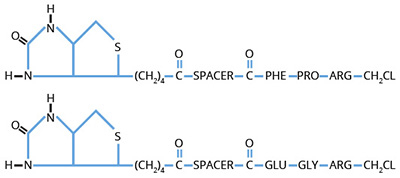Tri-peptide chloromethylketones have been utilized extensively to irreversibly inhibit various serine proteases (1-5). Among the most common chloromethylketones are FPRCK (Phe-Pro-Arg-chloromethylketone; commonly referred to as PPACK), which is a rapid thrombin inhibitor and EGRCK (Glu-Gly-Arg-chloromethylketone; commonly referred to as GGACK), which is a rapid factor Xa inhibitor (1). Both FPRCK and EGRCK are used extensively during protein isolation procedures to inhibit serine protease activity and prevent further conversion of zymogens to active enzymes. Recently, the modification of these tri-peptide chloromethylketones with reporting groups, such as fluorescent probes (6-8,14), radioactive labels (9) or thioreactive-labels (10), has provided a unique approach to the study of various serine proteases. These probes are useful because they allow a means of reporting molecular changes in an enzyme, and not its zymogen, while also inhibiting the enzymatic activity.
The use of biotin as a reporting group has been used extensively with antibodies in ELISA based assays and in western blotting. The biotin, in conjunction with avidin, creates a highly sensitive method for detecting antibodies, and therefore, antigens. By modifying the tripeptide-chloromethylketones with a biotin group, the sensitivity of the avidin/biotin system can be extended to study serine proteases without the need for specific antibodies to the active enzymes.
Biotinylated tripeptide chloromethyl ketones can be used in a variety of ways (11-13). First, the compounds can be reacted with unwanted serine proteases in a sample or preparation, and can then be removed along with the protease using avidin-Sepharose (11). Second, the biotinylated-serine protease can be visualized on a blot without the use of specific antibodies (11). Third, the biotinylated serine protease can be quantitated in an active-site specific immunoassay (12,13,15), such as the tPA-CASSIA (see Assay Kits). The spacer utilized on these compounds has been optimized to allow good reactivity of the biotinylated FPRCK and the biotinylated EGRCK in the above mentioned procedures.
In addition to biotinylated chloromethyl ketones, fluorescein labelled compounds are also available. The fluorescein labelled compounds are useful in both Western blot and fluorescent imaging applications.
Biotinylated and fluorescein labelled FPRCK and EGRCK are prepared by the method of Williams et al. (11).

